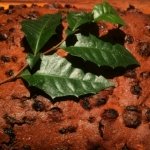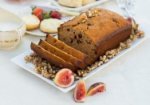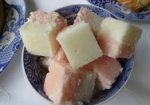Before you crush all your apples into cider as the Curator had us doing last week, we thought we’d celebrate ‘Eve’s fruit’ with some tried and tested family favourites from our heritage kitchens. We’ve featured apple hedgehogs and apple snow in more summery posts, but Apple Charlotte, pictured above, and Auntie Tottie’s Apple cake make perfect autumnal fare.
She’ll be apples
Almost invariably, it is the dessert sections of cookbooks that show the most wear and tear, and in older cookbooks, it is usually the apples recipes pages that show the heaviest use. Equally common is the number of apples recipes provided in English and Australian cookbooks, far outnumbering other fruit recipes. The cookbooks in our collections from Susannah Place, Rouse Hill House and Meroogal are no exception. The latter households had the benefit of apple trees growing in their orchards. Apples are highly versatile, easily attainable, relatively inexpensive, and they keep well. The number of varieties available also means that apples of some kind or other are in season for many months of the year.
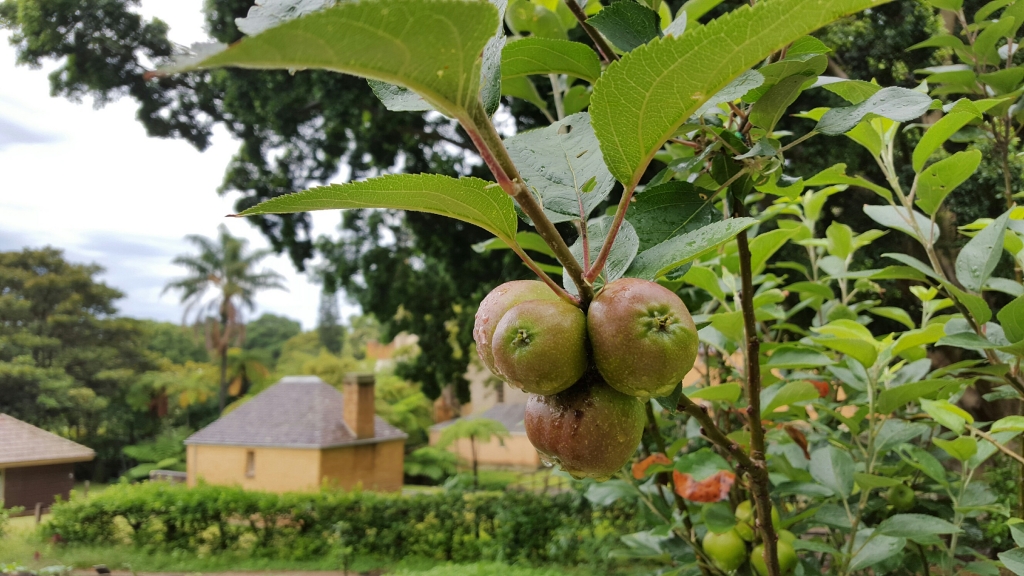
Quarrenden Apples in the kitchen garden at Vaucluse House Photo © Anita Rayner for Sydney Living Museums
A Royal dish
Although named after Queen Charlotte (1744-1818) wife of George III, the apple charlotte is a humble pie-like dessert, made with bread in lieu a pastry crust (see leading image, above). This was common practice in Georgian times – oyster loaves being another example, using hollowed out bread rolls to form a pie crust. Recipes for apple charlotte date back to the late 1700s, but this recipe is based one from Girlie Andersen’s Golden Wattle cookery book, 1948. Girlie lived at Susannah Place, in Gloucester Street, The Rocks between 1939-1964. Charlottes are very simple to make and inexpensive, which was important for working class families, especially during hard times.
Apple Charlotte
| Serves | 6 |
Ingredients
- 6 crisp apples (about 500 g) such as pink lady, fuji or jazz, peeled, cored, quartered and sliced, seeds removed
- 1/2 cup white granulated sugar
- 4 whole cloves
- zest of 1 lemon
- 100 g butter, softened
- 1 loaf of white sliced sandwich bread
- cream, ice-cream or custard, to serve
Note
This dish is reputedly named after Queen Charlotte, the wife of 18th-century British monarch George III, but remained popular well into the 20th century. Its beauty is in its humble style and simplicity. Serve with thick cream, ice-cream or warmed custard.
Serves 6
Directions
| Preheat oven to 200°C (180°C fan-forced). Put the apple in a saucepan with the sugar, cloves, lemon zest and 1/2 cup of water, and simmer gently until the apple is just cooked and still al dente. Remove the pan from the heat. Remove the apple pieces from the syrup with a slotted spoon and set aside. Reheat the syrup and reduce it to a light pouring consistency. | |
| Meanwhile, grease a 22-cm pie dish with some of the butter. Butter 12–15 slices of bread, and remove and discard the crusts. Cut the bread into fingers or triangles and line the base and sides of the pie dish with the pieces, buttered side up, ensuring that each piece overlaps slightly so that there are no gaps, and that the bread reaches the rim of the dish. Arrange the bread neatly, remembering that when turned out, this will form the top of the charlotte. Spoon the apple into the dish and cover with the remaining pieces of bread, buttered side down (butter more slices as needed). Press the edges of the bread together so that there are no gaps. Trim any untidy edges if necessary. Bake for 20–25 minutes or until the top of the pie is nicely browned, then remove from the oven and allow it to rest in the dish for a few minutes before turning it out onto a board or serving plate. Serve warm, with a drizzle of the syrup and cream, ice-cream or custard. | |
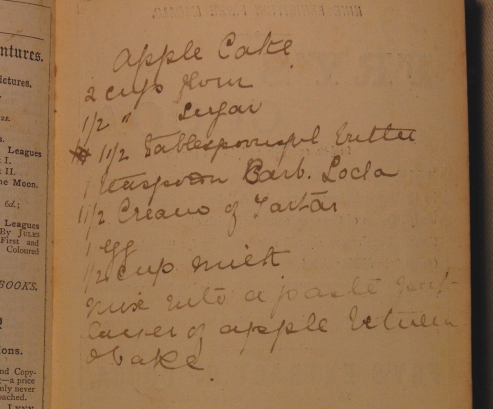
Apple Cake recipe written into Tottie Thorburn’s copy of Mrs Beeton’s The English Woman’s Cookery Book. Meroogal Collection. Photo © Sydney Living Museums.
Auntie Tot’s apple cake
Meroogal’s Auntie Tot, or Tottie had a favourite apple cake recipe (above). Made with freshly laid eggs and homegrown fruit, it is simple in style but has a lovely homely flavour. As with many of the manuscript recipes in the Meroogal collection it is a ‘shorthand’ recipe, the cook being expected to know the making process (see my method below). Apples aren’t mentioned in the ingredients list and no method or cooking times are given but for ‘mix into a paste just layer of apples between & bake’.
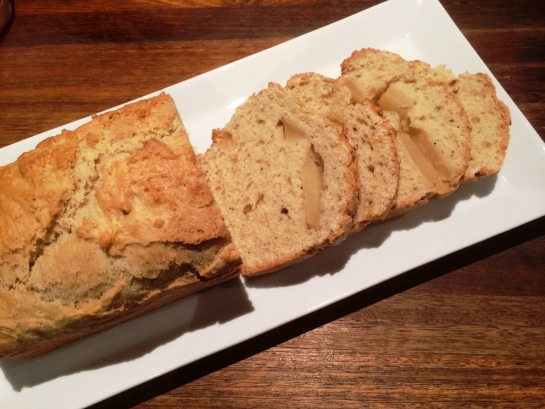
Tottie’s apple cake. Photo © Jacqui Newling for Sydney Living Museums
Apple cake
Ingredients
- 300g flour
- 1 teaspoon bicarbonate of soda
- 1.5 teaspoons cream of Tartar
- 1 teaspoon ground cinnamon or sweet spice (optional)
- 30g butter, softened to room temperature
- 1/2 cup caster sugar
- 1 egg, well beaten
- 150ml milk
- 2 apples, peeled, sliced and lightly poached
Note
Apple cake was one of Auntie Tottie's specialties. This recipe has been adapted from an apple cake recipe which was written into Tottie's copy of Mrs Beeton's The English woman's cookery book, circa 1890.
Directions
| Preheat the oven to C180° or C160° fan forced, and grease a loaf tin or 20cm round cake tin with butter. Sift the flour, bicarbonate of soda and cream of tartar into a large bowl. Add spices if using. Beat the butter and sugar together until pale and creamy, then beat in the egg and milk. Add the mixture to the dry ingredients, and stir gently with a wooden spoon until all the flour is incorporated and a thick batter is formed, adding a little more milk if it seems too heavy. Spoon half the mixture into the cake tin and layer the apples across the batter. Spoon the remaining batter over the apples and bake for 30-40 minutes of until the top is golden and a skewer comes out clean. (The cooking time will vary depending on the shape of the baking tin). Allow to cool in tin for 15 minutes and then turn out onto a cooling rack. | |
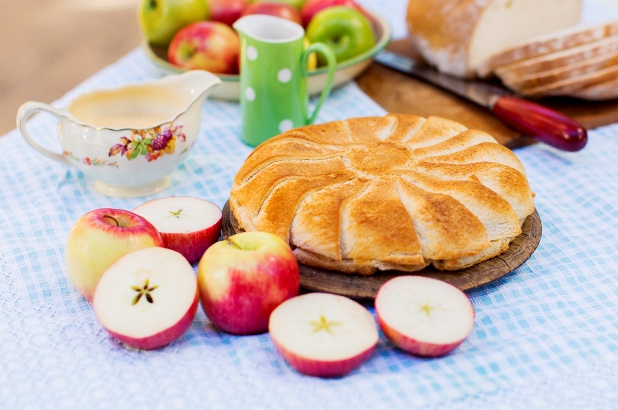
 Print recipe
Print recipe